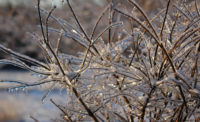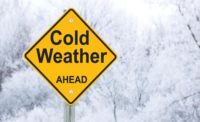Winter forecasts from the Farmer’s Almanac 2017-2018 range from cold and snowy for the Northeast, to mild for the Southwest, to everything in between for the rest of the country. Just about everywhere, workers must remain mindful of the weather — and its effects on the environment and the body — to stay safe while working outdoors.
For much of the U.S. and Canada, winter brings more than cold. Work environments — dark, wet, icy, windswept, and even snowbound — present multiple challenges for individuals who must work outside. To start with, as their core temperatures drop, workers automatically begin to shiver. That’s the body’s way to generate heat and maintain a normal, healthy temperature. But shivering uses energy. And when it’s cold, muscles tense up, expending even more energy. Finally, movement in heavy, bulky winter clothing is often restrictive and difficult.
The likely results: fatigue and loss of focus. The pace of work slows; more breaks are required; short cuts are taken; and productivity suffers. And tired, distracted, uncomfortable individuals are less likely to “work safe.” So when temperatures fall, so do safety levels.
Safety managers must respond by performing a proper hazard assessment. In extreme cases, work schedules and practices may need modifications. In most cases, safety managers must select and assign appropriate personal protective equipment (PPE) for reducing heat loss — to meet the head-to-toe requirements of working in winter’s colder, harsher world.
Head, face and eyes
Scientists have debunked the myth that, in cold conditions, most body heat is lost through our heads. But basically, heat is lost through any body part left uncovered. So you still want to select properly insulated headgear such as hats or hoods, with closures such as zippers, drawstrings, or hooks-and-loops to exposed skin. Especially frigid conditions may call for balaclavas or thermal face masks. Make sure of proper fit and adequate eye openings to maintain visibility of job tasks and hazards.
Guard against eye injury from rain, ice, or wind with the comfortable yet multifaceted protection of new hybrid spectacle/goggle sealed eyewear models. Combat safety eyewear’s number one jobsite challenge — lens fogging — with effective lens coatings. New polycarbonate materials help guard against dust, wind and extreme cold while offering peripheral vision to maintain awareness of the larger work environment. To reduce glare from snow, ice, and winter sun, suit lens tints to both environment and task. Polarized lenses offering protection against ultraviolet rays are important, as the sun sits at a much different angle during the winter, affecting the eyes at a lower position.
Body
Layers provide the most effective, flexible bodily protection. Begin with an outer shell to repel wind, rain, snow, and sleet, backed by high-performance thermal insulation to reduce loss of body heat. Storm flaps over closures and other openings help keep out the elements. Insulated undergarments futher regulate body temperature. Some flame-resistant (FR) protective clothing has the added advantage of offering protection in extreme cold-weather conditions. High-visibilty colors and retro-reflective bands further enhance safety when working in low-light conditions, at night, or in proximity to mobile equipment or vehicles.
Breathing
Breathing apparatus can also be impacted by low temperatures. Respirator performance may be compromised: valves may freeze open or shut in extreme cold. Check equipment manuals to ensure that selected respirators are both durable and resistant to the lowest temperatures likely to be encountered.
New lightweight powered air-purifying respirators (PAPR) can reduce or delay fatigue that can occur with hours of wear while working in cold weather. Fleece balaclavas favored by mountain climbers and Antarctic scientists can help workers by humidifying and warming the air for more comfortable breathing.
Hands
Cold and fatigue combine, causing workers to lose dexterity. They must work harder to grip their tools or to grasp anchor points for steadiness— increasing the risk of accidents for themselves or for others around them.
Select gloves for comfort and performance by taking advantage of new glove materials that promote grip and dexterity in cold, wet conditions. Longer cuffs (on gloves, coats, or both) prevent heat loss through exposed wrist or arm openings. Add quality winter wool or cotton liners to keep hands warm — and, just as important, dry.
Feet
Wet, snow-covered, or icy worksite surfaces dramatically increase the danger of slips, trips and falls. Choose the correct safety footwear for these conditions with care. The wrong outsole in the wrong environment increases the chance of mishaps and injury. Comfort is also a key in selecting shoes or boots. Heavy, cumbersome, or inflexible footwear can promote worker fatigue —increasing the risk of a slip, trip, or fall.
Moreover, when working at height, surfaces are more apt to be wet, icy — and slippery — when wind is brisk and temperatures are low. Choose fall protection equipment that meets the latest ANSI and CSA testing requirements. Then go one step further: Research the extent to which selected products include cold and wet conditioning. Example: for some self-retracting lifelines, the minimum for cold conditioning is -40o F.
Health and wellness
Prolonged exposure to freezing temperatures can cause serious problems. Shivering followed by clumsiness and lethargy can mean hypothermia. Tingling, then numbness with white patches on skin may indicate frostbite. Dress in warm layers, minimize exposed areas, check yourself and co-workers frequently, and seek shelter when necessary for rewarming.
Also, cold and flu cases climb during the chillier months. Symptoms can affect workers’ alertness as well as their productivity. Prevention is key. Wash your hands frequently to avoid spreading germs. In the absence of water, use hand sanitizer. Employers can reduce absenteeism by stocking their first aid kits with sinus pain relievers, plus multi-symptom cold tablets that help reduce fever, congestion, and muscle aches. They can also ease discomfort by offering cough drops for throat relief, or lotions for chapped skin.
Finally, workers in cold or extreme environments should never work alone. When conditions are hazardous, wet, and slippery, or when visibility is reduced, the buddy system lets workers check each other — and be assured that, in a crisis, somebody nearby “has their back.”
Cold weather protection starts with proper preparation. Despite low temperatures and other daunting winter difficulties, planning plus the right protective equipment let workers keep going, keep warm, and keep safe.


